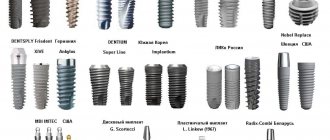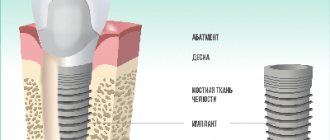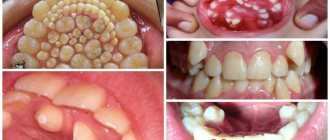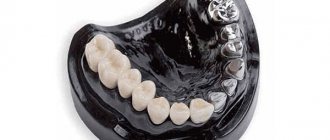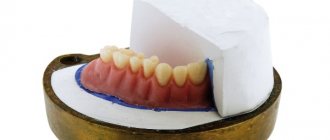Treatment options depend on the type of implant and the condition of the bone. Dental implantation can consist of several stages and take three months, but the result is worth the wait. You will receive new teeth that are in no way inferior to your original ones in terms of aesthetic and functional characteristics.
Why is dental implantation needed?
Implants are placed into the jawbone, where these metal screws act as roots for artificial teeth (dentures). Because the screws are completely fused to the bone, they will not creak, wobble, or damage surrounding tissue. The main thing is to prepare a solid foundation for them.
Implantation may be the best option if you:
- Lost one or more teeth
- Maintained sufficient healthy bone tissue
- You have no contraindications to surgery
- Unable or unwilling to wear dentures
- Strive to improve your appearance and speech
- Are you ready to devote several months to treatment?
It is worth understanding that surgical treatment, even such a “harmless” one, is associated with certain risks. In modern surgical dentistry, complications are extremely rare, but they cannot be completely excluded.
Complications include: infections of the peri-implantation zone, damage to nerves and blood vessels, as well as problems with the nasal sinuses (sinuses) during dental prosthetics of the upper jaw. Usually the complications are mild and can be quickly eliminated by the professional actions of the surgeon.
Contraindications to dental implantation include:
- Lack of sufficient bone tissue
- Acute infectious-inflammatory process in the oral cavity
- Severe bleeding disorders
- Conditions that slow healing
- Immunodeficiency conditions
- Heart diseases
Features of the engraftment stage
Statistics show that modern implant systems cause rejection in only 2% of cases 1 . Most often, such situations are the result of medical errors or patients’ failure to comply with doctor’s instructions regarding oral care after surgery. Full engraftment, that is, the fusion of the structure with bone tissue, occurs in about six months. During this period, it is recommended to reduce the load on the teeth, as well as use lightweight prosthetic models - a plastic design that does not interfere with the correct positioning of artificial roots would be an excellent option.
Preparation for dental implantation
Since the treatment involves several procedures, the doctor must carefully examine you, make sure there are no contraindications and prepare a clear plan.
X-rays and computed tomography (CT) allow us to assess the condition of teeth, bones and surrounding tissues, so no specialist will begin responsible treatment without pictures. In this case, CT is superior to conventional x-rays, as it allows one to obtain detailed layer-by-layer images.
Based on the results of the examination, a treatment plan is drawn up, which takes into account numerous individual factors: the number of teeth for implantation, location, condition of the jaw bone, sinuses, etc.
When planning, you may need to consult several specialized specialists (for example, an otolaryngologist or an oral and maxillofacial surgeon).
Be sure to tell your doctors about your chronic diseases (such as cancer or diabetes), medications, and dietary supplements you are taking. If you have serious heart disease or have orthopedic implants (such as an artificial hip), this may affect your future treatment.
For effective pain relief during surgery, local anesthetic, sedation, and general anesthesia (anesthesia) are used. After surgery, antibiotics are prescribed to prevent infections. It is important to know if you have any allergies to medications.
Advantages of the technology:
- Full understanding and interaction between specialists (surgeon, orthopedist, dental technician) in choosing the optimal prosthesis design, the ability to involve related specialists before and at the stage of implantological rehabilitation;
- Correct placement of implants as a support for planned orthopedic structures;
- Selection of the optimal operating technique for each clinical case;
- Accurate positioning of implants according to all requirements in the planned location;
- 4-fold acceleration of operation time;
- Minimal trauma, pain and swelling in the postoperative period;
- Predictable and 100% guaranteed final aesthetic result;
- Possibility of performing the procedure using a bloodless method and without incisions;
- Eliminating the likelihood of unwanted complications and damage;
- Makes it possible to carry out precisely calibrated and safe operations.
A natural question arises. What method would I like to use to install implants for myself? Using the classical method - “by eye” or using navigation implantation technology ?
How is dental implantation performed?
This is an outpatient treatment that is carried out in several stages:
- Extraction of a damaged tooth
- Preparation of the jawbone, including tissue augmentation
- Installation of an implant with a plug in the jaw, which should integrate into the surrounding tissue within several months
- Opening the implant, removing the plug and installing the so-called healing abutment for a period of one and a half to two weeks
- Installation of an aba between the implant and the prosthesis) followed by placement of a new artificial tooth on it
The entire process of dental implantation may well take over six months, which is explained by the slow restoration of tissues and integration of the implant.
Who needs bone grafting?
Bone grafting (osteoplasty) in dentistry is a complex procedure aimed at building tissue in preparation for implantation.
Many patients avoid this procedure, but in case of jaw injuries or bone atrophy, osteoplasty is mandatory. It is an inevitable step for the long-term installation of dental implants on weakened bone.
There is nothing to be afraid of. This is a common and well-established procedure that is performed slightly less frequently than implantation itself. Technologies and bone materials have advanced so much that in some cases it is possible to perform osteoplasty and dental implantation almost simultaneously.
Indications for bone grafting
If in past decades osteoplasty was usually used to restore an injured jaw, today the emphasis has shifted towards other requests.
The aging of the population and the loss of “native” teeth poses the challenge for doctors to maintain a high quality of life and a beautiful smile at any age.
But after a previous tooth extraction, atrophy of the alveolar process
- an irreversible natural process in which the bone bed degrades, making prosthetics impossible.
Among the causes of alveolar process atrophy:
- Jaw injury
- Complications of extraction
- Delayed dental prosthetics
- Anatomical features
- Inflammatory processes
The result of atrophic processes can be not only bone deformation, but also speech impairment, cosmetic defects in the form of asymmetry of the lower part of the face.
Treatment for alveolar process atrophy is only surgical, and consists of plastic surgery with special biomaterials (natural and synthetic bone substitutes). These materials lay the foundation for future implants.
Contraindications to bone grafting
Osteoplasty is technically complex and has many features and contraindications.
To determine the degree of bone tissue deficiency and the possibility of performing a particular procedure, you need to consult an experienced implant surgeon. So, you have to take into account the thickness of the alveolar ridge and the features of your anatomy.
Contraindications to bone grafting include:
- Acute inflammatory process
- Immunodeficiency conditions, chemotherapy
- Severe bleeding disorders
- Oncological diseases, including head and neck
- Mental disorders and alcoholism
- Severe cardiovascular diseases
- Contraindications to anesthesia
- Pregnancy and lactation
If your contraindication is temporary and can be eliminated with appropriate treatment, nothing further will prevent surgical treatment.
If the patient has no absolute contraindications to osteoplasty, even the most complex cases of bone deficiency can be corrected surgically. The main thing is that an experienced doctor who uses modern technologies and materials gets down to business.
In some cases, only minor bone augmentation is required, which is performed at the same time as the implant surgery.
Implant installation
This operation is painless because it is performed under local anesthesia. The surgeon cuts the gum, prepares the bed and drills a hole in the bone tissue to install the implant. Since it will bear heavy loads, the implant is screwed deep into the jawbone.
A tiny plug screw is placed on top, which will not allow tissue to grow inside the implant. The wound is then sutured, leaving the implant inside for a long time. This time - from three months to six months - is necessary for complete osseointegration, that is, the metal becomes overgrown with bone tissue.
Abutment installation
When osseointegration is complete, a second operation will be required - installation of an abutment, a metal transition element between the prosthesis and the implant. It is also performed under local anesthesia and takes very little time.
Why do you need an abutment? In case of destruction of the prosthesis. Can you imagine if, if you need to change your prosthesis, you will have to go through the entire treatment from A to Z again? Thanks to the adapter, you can easily remove the prosthesis and install another one in its place: the implant remains in the jaw and unnecessary operations are not necessary.
Choosing dentures
After the abutment is placed, the gums are allowed to heal for two weeks before dentures are placed. When the gums are completely ready, you can already imagine the appearance of the new artificial tooth.
At the final stage, a suitable denture is installed:
- Removable denture
: This design closely resembles traditional dentures. Contains a row of artificial white teeth surrounded by pink plastic gum. Mounted on a frame that is attached to the abutments for secure retention. Easily removable for cleaning.
- Fixed Dentures
: Despite all the benefits of removable dentures, fixed dentures are durable, easy to handle (clean just like natural teeth), and are considered the best option for replacing individual teeth.
A few words about prices
The full cost of dental implantation depends on many aspects: the number of missing teeth, the presence of concomitant diseases, the condition of the bone tissue, the choice of a specific method of operation, the model and number of implants, and the pricing policy of dentistry. For example, implantation of one tooth will cost from 35 thousand rubles - it all depends on the technology, brand of the implant, as well as the material from which the crown is made.
How much money does it take to restore a tooth with implantation?
As for the complete restoration of the dentition, the scatter is quite large. Restoration of one row of teeth starts from 180 thousand rubles and can reach 550 thousand. Again, the chosen technique, type of prosthesis, number of implants and their brand influence.
Possible complications after implantation
After any stage of treatment, typical complications may occur:
- Infection
- Bleeding
- Swelling of the gums and face
- Nerve injury
- Pain in the installation area
- Implant mobility
- Implant exposure
- Product breakdown, etc.
If swelling, redness and pain do not subside, worsen within a few days after surgery, or are accompanied by new symptoms, contact your surgeon. You may need antibiotics, pain relievers, or other help.
Immediately after each stage (surgery), the doctor will recommend not to injure the gums and refrain from spicy, salty or hard foods. Typically, absorbable suture material is used in dentistry; otherwise, after suturing the wound, an unpleasant manipulation will be required - removal of the sutures.
Trust the beauty of your smile to professionals
Dentistry in Lyublino “Good Hands” has been operating on the Moscow market for more than 5 years and has earned a huge number of positive reviews from regular customers. We carry out:
- Comprehensive diagnostics.
- Taking impressions and creating a plaster model.
- Selection and installation of implants.
- Monitoring results and assistance in the rehabilitation process.
We use the best implants from manufacturers from Switzerland, Germany, and Israel. To make an appointment for diagnostics, call us during business hours.
Results of dental implantation
Today, the vast majority of procedures are successful, but in some cases the implant may not fuse well with the bone. Smoking, for example, contributes to implant loosening and other serious complications.
If the implant becomes loose, the implant is removed, the bone is thoroughly cleaned, and you can try the treatment again after 2-3 months of recovery.
To prevent complications, doctors recommend:
- Oral hygiene
: Just like natural teeth, crowns need to be kept clean. Specially designed brushes for thorough cleaning of the interdental space will help avoid the accumulation of bacteria and inflammation.
- Regular visits to the dentist
: To prevent infections, preserve implants and receive timely care, visit your doctor every six months.
- Avoiding bad habits
: in addition to smoking, which contributes to loosening of the implant, you should not chew very hard food (caramel) or use new teeth for other purposes. Let's say, for opening bottles.
Take care of your health and return to the surgeon as rarely as possible!
Alternative solutions
Alternative solutions to the problem include prosthetic methods supported by living teeth or gums - bridges and removable dentures. They are characterized by their advantages and disadvantages, however, according to reviews from doctors and patients, they have one significant disadvantage - such solutions are not able to stop the atrophic processes of bone tissue, which is why it is rapidly decreasing in volume.
- prosthetics with bridge-like structures: the product consists of interconnected artificial crowns that are attached to the supporting teeth adjacent to the defect. In this case, living teeth are subjected to grinding,
- installation of a removable denture: removable-type structures are used to replace both part and all teeth in a row. They can be equipped with special fasteners that cling to the supporting teeth. Fully edentulous models are fixed directly to the gums by suction.
Photos before and after dental implantationVideo review of a patient about the restoration of all teeth using implantation with immediate loading


